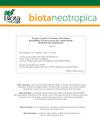Entomological survey of phlebotominae sand flies (diptera: psychodidae) and vector species in the tegumentary leishmaniasis endemic area in eastern brazilian Amazon, Amapá state
IF 1.2
4区 环境科学与生态学
Q3 BIODIVERSITY CONSERVATION
引用次数: 0
Abstract
Abstract: American tegumentary leishmaniasis is an endemic that has increased considerably in recent decades in the Amazon region, sand flies are the vectors of the transmission of the protozoan that causes leishmaniasis, so the objective of this study was to carry out a survey of the diversity of species and the presence of Leishmania DNA in vectors circulating in three endemic counties for tegumentary leishmaniasis in the eastern Brazilian Amazon (Amapá state, Brazil). Using CDC light traps, a total of 10,773 specimens were collected between February 2019 and February 2020, representing 64 species in 15 genera. The vector specie Nyssomyia umbratilis Ward and Frahia, 1977 was the predominant species (13.20% of the total), being collected in all three counties, followed by Trichopygomyia trichopyga Floch & Abonnenc, 1945 (11.41%), Trichophoromyia ubiquitalis Mangabeira,1942 (9.47%) and Nyssomyia anduzei Rozeboom, 1942 (7.61%). For the identification of Leishmania DNA, 775 pools of unengorged females were used, of which 5 tested positive, 2 of Nyssomya umbratilis Ward & Fraiha,1977, 1 of Nyssomyia anduzei and 2 of Psychodopygus davisi Root,1934, demonstrating a natural total infection rate of 0.64%. This study increases the knowledge of vector diversity, as well as identifying Leishmania spp. in circulation in the eastern region of the Amazon.巴西亚马孙河东部阿姆阿帕州尾状利什曼病流行区白蛉科沙蝇(双翅目:沙蝇科)及其病媒昆虫学调查
摘要:美洲被盖利什曼病是近几十年来在亚马逊地区显著增加的一种地方病,沙蝇是引起利什曼病的原生动物传播媒介,因此本研究的目的是调查巴西东部亚马逊地区3个被盖利什曼病流行县(巴西amap州)传播媒介的物种多样性和利什曼原虫DNA的存在。2019年2月至2020年2月,采用CDC光诱法共采集标本10773份,代表15属64种。恙虫病媒介种为Ward和Frahia, 1977年为优势种,占总数的13.20%,其次为flch & Abonnenc, 1945年(11.41%),Mangabeira,1942年(9.47%)和Rozeboom, 1942年(7.61%)。为鉴定利什曼原虫DNA,共使用775份未吸血雌虫,其中5份检测阳性,其中2份为1977年,2份为1977年,1份为1934年,2份为1934年,自然总感染率为0.64%。这项研究增加了对媒介多样性的认识,并确定了在亚马逊东部地区传播的利什曼原虫。
本文章由计算机程序翻译,如有差异,请以英文原文为准。
求助全文
约1分钟内获得全文
求助全文
来源期刊

Biota Neotropica
BIODIVERSITY CONSERVATION-
CiteScore
2.90
自引率
16.70%
发文量
0
审稿时长
4-8 weeks
期刊介绍:
BIOTA NEOTROPICA is an electronic, peer-reviewed journal edited by the Program BIOTA/FAPESP: The Virtual Institute of Biodiversity. This journal"s aim is to disseminate the results of original research work, associated or not to the program, concerned with characterization, conservation and sustainable use of biodiversity within the Neotropical region.
Manuscripts are considered on the understanding that their content has not appeared, or will not be submitted, elsewhere in substantially the same form, because once published their copyrights are transferred to BIOTA NEOTROPICA as established in the Copyright Transfer Agreement signed by the author(s).
 求助内容:
求助内容: 应助结果提醒方式:
应助结果提醒方式:


